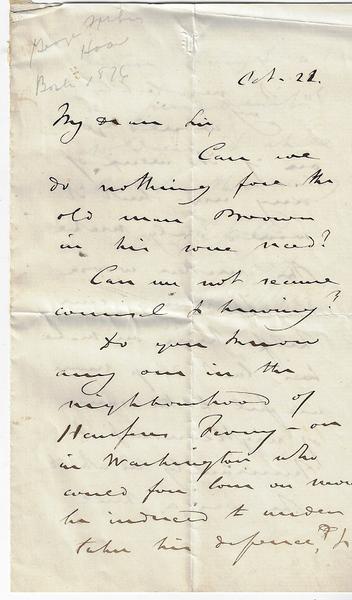John Brown and the Harpers Ferry Raid

THE DEFENSE OF ABOLITIONIST JOHN BROWN AND HIS HARPER’S FERRY RAID
An important antebellum letter concerning the defense of the abolitionist John Brown and his Harper's Ferry raid which took place between October 16 – 18, 1859. This letter concerning possible legal support for John Brown was sent on October 22, (1859). After the trial John Brown was hung on December 2, 1859. Howe’s letter is an attempt to find some legal representation for Brown.
John Brown was funded in part by six individuals who years later would be designated as the Secret Six. The group consisting of Franklin Sanborn a school teacher who also served as the Secretary of the Massachusetts State Kansas Committee. George Luther Stearns who was President of the Massachusetts Kansas Committee. Thomas Wentworth Higginson, a minister and one of Brown’s strongest supporters. Gerrit Smith, a millionaire antislavery philanthropist. Theodore Parker, a minister who was a strong supporter of slave revolts, women's rights, temperance and prison reform and Samuel Gridley Howe, a doctor and future director of the Perkins Institute for the Blind in Massachusetts.
The letters author, Samuel Gridley Howe, was also an active abolitionist. He had helped create an organization that tried to settle anti-slavery voters in Kansas who aimed to turn Kansas into a free state. Before it ran out of money, the organization purchased 200 Sharps rifles for use of the settlers. Howe was enthusiastic about Brown and his band of raiders plan to capture the rifles at the armory. The weapons would then be handed out to local slaves who would join him in the uprising. Brown had tried and failed to recruit more men to support his efforts. In the end only 22 people participated in the raid. But he had convinced the Secret Six to divert their rifles — originally destined for Kansas — to Virginia to arm his raiders. Brown and his miniature army succeeded in capturing the armory, albeit only for a day. And the uprising never occurred.
Following Brown’s conviction in Virginia, his Boston supporters raised money for one last appeal. They hoped to have Brown’s case reheard in federal court. Howe supported the appeal, but he realized he could be forced to go to Virginia if a federal court took on the case. He fled to Canada. Howe also went further and published in a New York newspaper a disavowal of any knowledge of Brown’s plans. He would later admit his statement was misleading, at best, if not an outright lie.
George Frisbie Hoar to whom the letter is written was an attorney and politician who represented Massachusetts in the U.S. Senate from 1877 to 1904. An abolitionist and and Radical Republican, Hoar recognized the immorality of slavery and was raised in a household which actively opposed racial bigotry and often defied laws they deemed unjust. Hoar strongly opposed and assailed the Democratic Party, which he viewed as the party of the saloon keeper, ballot box stuffer and Klansman. Between 1856 and 1857 Hoar was active as a Kansas Free-Stater, supported the Freedmen’s Bureau, and took a leading part in reconstruction legislation.
Sources: New England Historical Society; UMKC School of Law
(Letter in full)
Oct. 22 (1859)
My dear Sir,
Can we do nothing for the old man Brown in his ____ need?
Can we not secure council & hearing?
Do you know anyone in the neighborhood of Harpers Ferry or in Washington who could for love or money be induced to undertake his defense & do it ______?
I would go on if it were of any use – but it would only make the matters worse.
If money can help him, or make his last days more useful to the cause of righteousness & humanity in which he was true because though not a prudent soldier it shall be forthcoming.
Faithfully
S.G. Howe
ALS. 2 pg. 5 x 8 inches. A short vertical separation, crinkling to the first page and mounting remnants to the blank verso.
